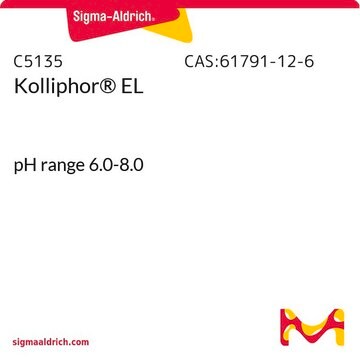15759
Poli(etilenglicol)-bloque-poli(propilenglicol)-bloque-poli(etilenglicol))
Sinónimos:
Poly(ethylene glycol)-block-poly(propylene glycol)-block-poly(ethylene glycol), Lutrol F68
About This Item
Productos recomendados
formulario
solid
Nivel de calidad
mol peso
~7680-9510 g/mol
composición
oxyethylene, 79.9-83.7%
impurezas
≤0.25% ethylene glycol and diethylene glycol
≤0.4% total ash
≤1 ppm ethylene oxide
≤1.0% water
≤2 ppm arsenic traces
≤20 ppm heavy metals
≤5 ppm dioxan
≤5 ppm propylene oxide
50-150 ppm butylhydroxytoluene
residuo de ign.
≤0.30%
color
APHA: ≤120, 50/50 in CH3OH
pH
5.0-7.5 (100 g/L in H2O)
6.0-7.5 (25 g/L in H2O)
CMC
0.48 mM
temperatura de transición
cloud point >100 °C
HLB
>24
InChI
1S/C3H6O.C2H4O/c1-3-2-4-3;1-2-3-1/h3H,2H2,1H3;1-2H2
Clave InChI
RVGRUAULSDPKGF-UHFFFAOYSA-N
¿Está buscando productos similares? Visita Guía de comparación de productos
Aplicación
- Stabilizing Function of P 188 in Dermal Formulations: Examined for its stabilizing effects on industrial concentrates of dermal hesperidin smartCrystals, P 188 contributed to enhancing the long-term stability of the formulations, relevant for dermal therapeutic interventions (Romero et al., 2015).
Acciones bioquímicas o fisiológicas
Otras notas
Información legal
Código de clase de almacenamiento
11 - Combustible Solids
Clase de riesgo para el agua (WGK)
WGK 1
Certificados de análisis (COA)
Busque Certificados de análisis (COA) introduciendo el número de lote del producto. Los números de lote se encuentran en la etiqueta del producto después de las palabras «Lot» o «Batch»
¿Ya tiene este producto?
Encuentre la documentación para los productos que ha comprado recientemente en la Biblioteca de documentos.
Los clientes también vieron
Nuestro equipo de científicos tiene experiencia en todas las áreas de investigación: Ciencias de la vida, Ciencia de los materiales, Síntesis química, Cromatografía, Analítica y muchas otras.
Póngase en contacto con el Servicio técnico





